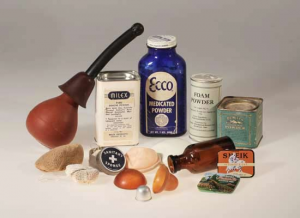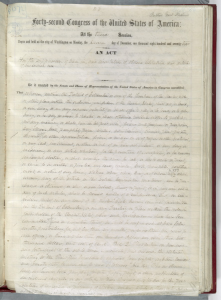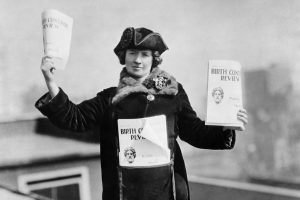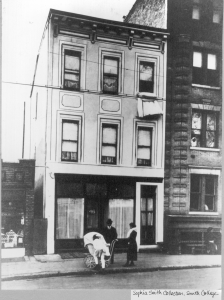Author-Girely Temoxtle
Introduction
Contraceptives and abortion have been around in the early stages of civilization, before the terms were coined and as technology kept improving over decades, the better these methods became for women in society. Prior to the late 20th century, women in society were not given the same rights one might have today regarding information and accessibility to contraceptives, nor the right to have an abortion. In the early days of civilization, people would use these methods such as: devices, potions, and chants, to try to prevent pregnancy.1 One of the most common forms and oldest technique of earlier methods to prevent pregnancy is abstinence, or withdrawal that dated back to the Bible. Preparations for oral contraception, included recipes of leaves or bark of hawthorn, ivy, willow, and poplar.1 Also mentioned in the article, in the Middle Ages, many women died of lead, arsenic, and mercury poisoning that was viewed as “ highly contraceptive.” The physical barrier method of contraceptives included: covering the genitals with cedar gum and applying alum to the uterus. Pessaries, a soft, flexible device that is placed in the vagina, made of mixtures of elephant or crocodile dung and lime and pomegranate seed, were inserted into the vagina to prevent pregnancy. To conclude, wool tampons soaked in wine, sicklewort leaves, sponges, and gold balls, were also used.1 In the 16th century through the 20th century, the discovery of condoms in 1709, and in the early 1800s, along with the contraceptive sponge and contraceptive syringe were used. The contraceptive syringe was immediately used after ejaculation to inject an aqueous solution of alum (zinc sulfate) into the vagina became readily available.1 Later on in 1909 the first intrauterine device (IUD), a ring made of silkworm gut, was made and described in Germany. Today women are lucky enough to be offered different methods of contraceptives, and women now have a say in what they can do with their bodies regarding abortion practices. In this paper, I will include how the availability of contraceptives was hard in the 19th and 20th century, the importance and role of the birth control advocate Margaret Sanger, and Abortion in the 19th and 20th century.
Accessibility of Contraceptives
The discovery of condoms in 1709 and in the early 1800s, and later on the easy access to manufacturing of rubber, led to the popularity of condoms, that caused prices to drop faster. 2 Along with condoms, the contraceptive sponge and contraceptive syringe were used, but the contraceptive syringe became more available because of the efficiency of it due to the syringe being immediately used after ejaculation to inject an aqueous solution of alum (zinc sulfate) into the vagina.1 Later on in 1909 the first intrauterine device (IUD), a ring made of silkworm gut, was made in Germany.

Timeline of the contraceptives prior ot the 1900s. Connell, E B. Contraception in the Prepill era,January 1999, pp.7S-10S. https://www.sciencedirect.com/science/article/pii/S0010782498001309

Picture of contraceptives in the 1900s. Case Western Reserve University. History of Birth Control, Dittrick Medical History Center,2019 https://artsci.case.edu/dittrick/online-exhibits/history-of-birth-control/
Even though these were options of contraceptives, birth control was technically illegal according to the Comstock Law of 1873, as it stated that it was “illegal to sell, publish, or possess an obscene book, pamphlet, paper, writing, advertisement, circular, print, picture, drawing or other representation, figure, or image on or of paper or other material, or any cast instrument, or other article of an immoral nature, or any drug or medicine, or any article whatever, for the prevention of conception or for causing unlawful abortion.” If anyone were to break the law, it would be considered a crime and the person would“be imprisoned at hard labor in the penitentiary for not less than six months nor more than five years for each offense, or fined not less than one hundred dollars nor more than two thousand dollars, with costs of court.3”

Picture of Comstock Law of 1873.National Archives. The Comstock Act of 1873, Records of Rights, David M. Rubenstein Gallery. http://recordsofrights.org/records/24/the-comstock-act
Because of contraceptive information and devices being seen as ‘obscene, lewd, or lascivious,3’ it became difficult to obtain contraception in the late 19th and early 20th centuries that made it nearly impossible for women to have reliable or time to space their pregnancies. This was the stepping stone for what later women and advocates would speak upon.
Margaret Sanger and the Birth Control Movement

Margaret Sanger distributing the Birth Control Review Magazine. Artsor. Margaret Sanger, Birth control advocate, University of Chicago, 1915. https://library.artstor.org/#/asset/ARTSTOR_103_41822001764792
Maragret Sanger became the face and advocate for the birth control movement, for as a nurse, Sanger saw the effects of uncontrolled childbearing and unsafe abortions, and also witnessed maternal and infant deaths resulting from childbearing. So being a nurse, often she would have patients complain that they could not afford to properly raise the child, or more children. Because of experiences like these, this led her to quit her job and advocate to find a method to spread contraceptive knowledge to everyone, since during the time it was illegal. Because of the horrors that went on during child labor, Sanger wanted an oral method of birth control to be provided to the ‘lower classes’ so they can begin using it, since they were the ones that needed it the most. 4 Sanger was also the founder of Planned Parenthood, when she opened her first birth control clinic in Brooklyn in 1916, which later on she was arrested for illegal distribution of contraceptive information. The purpose of the clinic was to provide contraception and preventive gynecology such as: sex education to women who were not tuaght it, marriage counseling, infertillity couseling, referraks for safe, illegal abortions.5 Because of this she was arrested for it was still illegal under the Comstock Law to distrubute or provide infromation regarding contraceptives and abortion practices. In 1917 she was arrested for distributing an early version of a diaphragm at the clinic, that led to New York law allowing doctors to prescribe contraceptives for medical purposes. Sanger’s viewpoint of pregnancy was that one should have a child by choice, and not let it be an “accident,” for this would help women’s role in society.4 Sanger would after on urge reproductive biologist Dr. Gregory Pincus to begin research into an oral medication as an alternative of the physical and other birth control methods, that would not be done until 1960. Alongside Margaret Sanger, Mary Dennett founded the National Birth Control League in 1915—the first birth control organization in the USA where she insisted that doctors had a duty to their patients to give them proper contraceptive information and that only the reason they did not was because of the law. Dennett argued that preventing women’s physical and psychological pain was the key to legalize birth control.4 Similarly Margaret Sanger also established the American Birth Control League in 1921, which noted the horrors of high maternal mortality rate and insisted that only legal birth control could help eliminate the problem.Although both of them had different visions concerning birth control, they both wanted contraceptive methods to be spread and accessible more easily to women.
The perspective of contraceptives and birth control at the time is mixed, and still continues to be an argument in the 21st century. Arguments made during the time why there should be a form of birth control and contraceptive methods, was because of the difficulty of keeping abstinence which was seen as unrealistic, it is not harmful, it brings happiness, it helps during economic problems, and it helps with the overall health of one. Those that opposed contraceptives or birth control claimed because of religion it was bad, It’s use was indiscriminate, it’s selfish and immoral, and it leads to worse family and state results. Those that opposed claimed that “Research” proved these devices are ineffective and harmful, and are sold for cheap. Also if it was for a negative purpose for the use of birth control, woman were considered a child murderer, and that it would most likely lead to the practice of abortion.6 Later on and even today the decision is basically based on the couple in the circumstance they are in.
Abortion up to the 1930s
Under common law, from the 13th century until the early 19th century, abortion was permitted for the first 20 weeks of pregnancy.7 The belief in the that time period was that life began once the fetus first moved in the womb, which was around the 20th week of pregnancy, and this change in perspective is what shifted in abortion law.7 From the early 1800s until 1973, abortion laws shifted to a restrictive state after the American Medical Association viewed that life began at fertilization, that ultimately lead to a nationwide movement to pass state restrictions of non therapeutic abortions throughout pregnancy.7 The late 19th century wanted to restrict abortion because it was seen as a form of homicide. Because of this view during the time, Doctors, almost always male, did not usually prescribe birth control nor perform abortions. Instead, the role of women such as midwives, herbalists, or sometimes neighbors, knew the necessary herbs, the effective formula, for dealing with these situations. Hundreds of women lost their lives every year from “botched” abortions, casuing them to bleed to death or die of sepsis, because abortion was illegal.8 The Inability to control infertility, was frustrating, for those with many children were starting to become overwhelmed. During the time the catholic church didn’t allow birth control or contraceptives, if not one would be fined or imprisoned. In connecticut for example, no contraceptives were allowed, states a doctor and only hysterectomy and vaginal hysterectomy were performed.9 Margaret Sanger grew up in a poverty environment where her mother got pregnant 18 times, and died at the age of 49 which wasn’t uncommon in the 19th century. Because she witnessed this during her childhood and with other women being desperate to control pregnancies, this was another reason why she wanted a better method for the prevention of pregnancy besides condoms and diaphragms.9 Other reasons for wanting an abortion could be due to the poor living conditions of families, and economic hardships, or not being able to take care of the child at that moment of time.

Margaret Sanger’s First Abortion Clinic in 1916. Estherkatz. Brownsville Clinic Open 99 years ago, Margaret Sangers Project,October 16, 2015. https://sangerpapers.wordpress.com/tag/brownsville-clinic/
This therefore led to Margaret Sanger opening her first birth control clinic in Brooklyn in 1916, which later on led to the formation of Planned Parenthood. As stated previously before, despite abortion laws, illegal abortions, information given on contraceptives and abortion, and planned parenthood that went on in this clinic, it led to the arrest of Sanger and shut down of the clinic.
Conclusion
To conclude, having access to contraceptives prior to the 21st century and having say on aboriton practices was not an option for most women in society during the time period, but as women were seeing the realities and problems of childbearning, ultimately that is what sparked an idea and reform for change for the health and safety of women. Margaret Sanger and other advocates and supporters eventually got the oral contraceptive in the late 1950s, and led to the pill being approved by the FDA in 1960. Those that contributed to the pill impacted the lifestyle of how women should be living, and the freedom women deserved without facing hardships. Today, most women with insurance have access at their local clinic, as prescribed by their doctor, access to information regarding abortion clinics and contraceptive options, that was not freely open and accepted prior to the 21st century. Abortion went hand in hand with the birth control movement and even though it was illegal in the the late 1800s to the late 1900s, without women speaking up on the issue, the state or government would still control the right’s of women as we know from the imfamous case Roe v. Wade. Birth control and abortion are still two of the most controversial topics that is still being argued about, even during presidental campaigns. Without Margaret Sanger and others who defied social norms at the time, and defied laws and government, we would not have freedom to make choices individually without having government, state, or society make them for us.
Footnotes
- Connell, E B. Contraception in the Prepill era, January 1999, pp.7S-10S. https://www.sciencedirect.com/science/article/pii/S0010782498001309
- The National Museum of Civil War Medicine. Mother’s Friend: Birth Control in 19th century America, Feb 5, 2017. http://www.civilwarmed.org/birth-control/
- National Archives. The Comstock Act of 1873, Records of Rights, David M. Rubenstein Gallery. http://recordsofrights.org/records/24/the-comstock-act
- Thompson, Lauren Maclvor. The Politics of Female Pain: Women’s citizenship, twilight sleep, and the early birth control movement, Medical Humanities, March 2019, Vol. 45(1),pp.67-74. https://mh-bmj-com.proxy.lib.odu.edu/content/medhum/45/1/67.full.pdf
- Chesler, Ellen. Margaret Sanger, birth control pioneer, Population Today, Apr 2000, Vol.28, p.3. https://search-proquest-com.proxy.lib.odu.edu/docview/235902560?accountid=12967&rfr_id=info%3Axri%2Fsid%3Aprimo
- Kennedy, Studdert. Is Birth Control Right? —A Debate, 1886-1930. July 1927, Vol. LXXVIII, Iss.No.1. https://search-proquest-com.proxy.lib.odu.edu/docview/90820909?accountid=12967&rfr_id=info%3Axri%2Fsid%3Aprimo
- Jacobs, Steven Andrew. Balancing Abortion Rights and Fetal Rights: A mixed methods mediation of U.S Abortion debate, The University of Chicago, ProQuest Dissertations Publishing,June2019. https://search.proquest.com/docview/2276919012?pq-origsite=primo
- Sweet, Victoria. Patients need Doctors with Conscious, Perspectives in Biology and Medicine,John Hopkins University Press, Project Muse, 2019, Vol.62. https://muse-jhu-edu.proxy.lib.odu.edu/article/732230
- PBS Video, The Pill, Brown, Blair, Gazit, Chana, VIVA; WGBH, Virtual Library of Virginia, Robertson Media Center, 2003. https://avalon.lib.virginia.edu/media_objects/bc386j260